Antifungal agent for walls: a comparative overview of the best options
Mold on the walls is not uncommon in modern homes and apartments. Spore formations multiply very quickly and if decisive measures are not taken to remove them, the fungus will migrate to the ceiling, floor, furniture and clothes.
For a quick solution to the problem, it is necessary to choose an effective antifungal agent for walls and eliminate the root cause of the appearance of mold microorganisms. We suggest you familiarize yourself with the most effective means of countering extremely dangerous biological effects.
We have described in detail how to use effective types of household chemicals, given options for the manufacture and use of folk formulations. The material is supplemented by visual illustrations and video guides.
The content of the article:
Signs and causes of fungus formation
The appearance of the fungus on the walls is an extremely unpleasant phenomenon that can negate costly repairs in the apartment.
Mold not only spoils the appearance, it worsens the indoor climate and is harmful to human health. Timely identification of the "enemy" greatly facilitates the fight against fungus. Details on methods to combat a dangerous biological phenomenon are described in one of articles of our site.
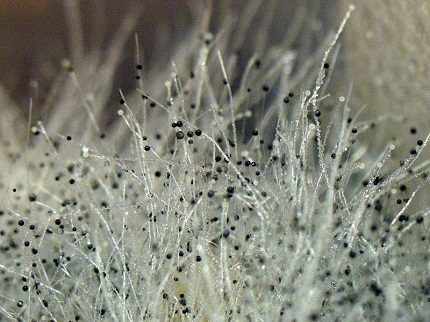
The following signs indicate the appearance of a fungus in the house:
- the presence of gray, black, dark green dots and spots on the walls or ceiling;
- the appearance of a raw, unpleasant odor in the room;
- peeling paint, wallpaper, plastering, and darkening tile joints.
Some may note a deterioration in well-being - the concentration of attention decreases, headaches become more frequent, and fatigue arises.
It is necessary to remove mold in an integrated manner. The final and irrevocable disposal of the fungus can be achieved by eliminating the causes of its appearance.
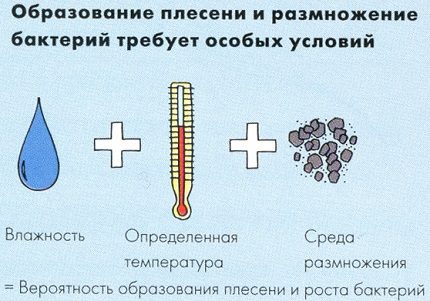
However, humidity and temperature indicators are far from the only factors in the development of harmful microorganisms.
Significant reasons include:
- Lack or inadequate ventilation. As a rule, the fungus begins to develop in the corners of the room - in the place where stagnation of air forms. With sufficient “blowing”, turbulences are formed - air blows out spores, and excess moisture is discharged into the ventilation duct.
- Poor waterproofing of the foundation. As a result of poor-quality construction, there is a capillary leakage of moisture from a moist foundation - the walls in the house become damp.
- Poor water supply and sewage. Periodic wetting of the floor, ceiling, walls and engineering channels creates a favorable environment for the development of the fungus.
- Thin freezing walls. Due to poor thermal insulation, a dew point shift occurs, condensate settles on the walls from the inside of the room.
- Cold attic or leaking roof. This is a common cause of mold on the upper floors and attics.
- Improper use of a humidifier. When creating tropical conditions for exotic plants, mold fungi sometimes settle in greenhouses.
Most decoration and building materials can be affected by fungus. Dark spots appear on the wallpaper, tile, wood trim and plaster.
In addition, mold is able to settle in household appliances, most often from its appearance washing machines, dishwashers and microwaves.
Varieties of fungicides
Most antifungal agents for walls contain fungicides - substances of biological or chemical origin that inhibit the development of fungi. Active components are added to various building compounds and mixtures to protect structural elements from mold.
Based on the destination, two groups of drugs are distinguished:
- primers for prevention;
- concentrated formulations for fighting.
Emulsions for prevention. The first group of antiseptics is used when performing repair work - before the walls are finished with a finish coating. Antifungal primers strengthen the base, increase adhesion, reduce the porosity of the material, remove mold and inhibit the further development of the fungus.
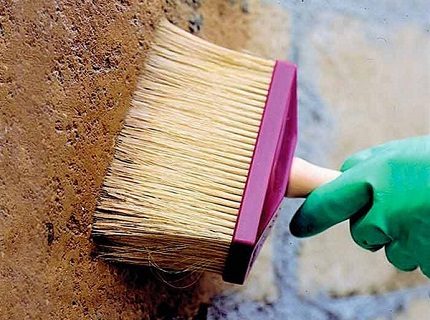
The determining factor in choosing a primer with an antiseptic against fungi and mold is the type of processing coating:
- reinforcing primer - suitable for putty and plastered walls for painting or wallpaper;
- deep penetration soil - optimal for low-porous substrates (drywall, brick and concrete), as well as for finishing with a “heavy” coating, for example, tiles;
- universal composition - processing of various types of surfaces.
Concentrates for mold removal. Means for treating surfaces affected by fungus. The compounds penetrate the structure of the material and destroy mold, lichens and mosses. Many concentrated preparations have a long-lasting effect and prevent re-infection.
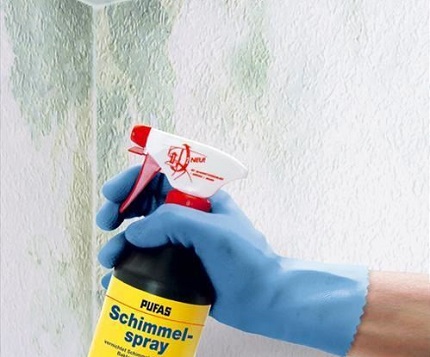
Emulsions for the prevention and removal of fungal formations are developed on the basis of different binders:
- Latex - the composition does not contain salts of heavy metals, so the tool is recommended for the treatment of walls in living rooms. An additional plus is air permeability.
- Acrylic - antiseptic drugs are applicable both indoors and outdoors.
- Alkyd - emulsions are often used to treat wood substrates.
The form of release of primers and concentrates is a ready-to-use liquid. In order to prevent fungal formations, the concentrated emulsion can be diluted with water.
Primers for prevention
To prevent mold in wet rooms at the stage of repair and construction work, it is advisable to use primers with an antiseptic property.
# 1: Milkill - Brick and Concrete Processing
Milkill is a latex emulsion, the active substance is a biocide that destroys spores of fungi and mold. Designed for the prophylactic treatment of finely porous and low absorbent surfaces after waterproofing before finishing work.
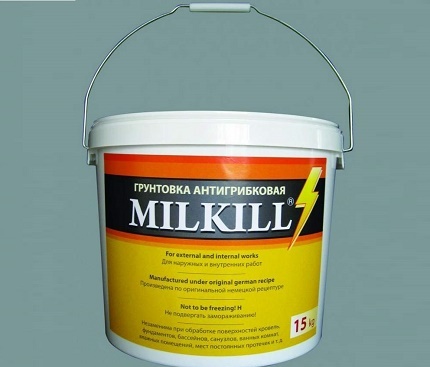
Characteristics and features of the use of the composition Milkill:
- consumption per layer - about 250 g / sq.m;
- It is recommended to apply 2-3 layers;
- drug penetration depth - 1-5 mm;
- complete drying time - 24 hours;
- white emulsion with a pungent odor;
- Suitable for work inside and out.
The composition of the primer is heterogeneous, so it must be mixed well before use. The work is carried out under positive temperature conditions (5-30 ° C).
# 2: Acryl Grundierung - Deep Penetration Composition
Acryl Grundierung (Olimpic) - deep penetration acrylic primer with anti-fungal and antibacterial properties. The tool is excellent for treating concrete, brick walls for putty, facade or interior painting, as well as applying decorative plaster.
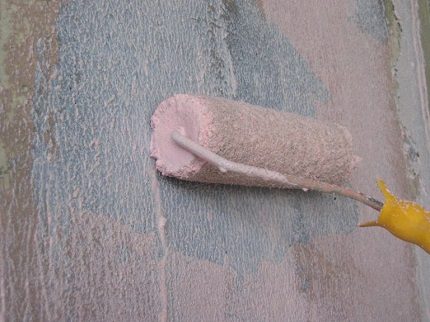
Technical and operational characteristics of Acryl Grundierung:
- practical consumption of material per layer - 1 l / 15 sq.m;
- drying period - 1 day;
- any types of water-based paints can be applied on top of the primer;
- "Working" temperature - 5-35 ° С.
The use of the composition significantly reduces paint consumption, reducing the absorption capacity of the surface. The antibacterial primer must not be poured into the sewer.
# 3: Schimmelstopp Dufa - fungicide supplement
Schimmelstopp Dufa highly concentrated primer is used as an additive to synthetic plasters and facade, waterborne dispersion paints. The concentrate has a long protective effect against the occurrence of mold, fungus and algae.
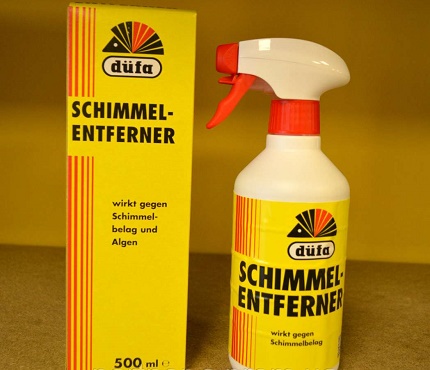
Technical information:
- the contents of the container are enough for 25 kg of plaster or 10 l of paint;
- the product can not be used at air temperature, the object is below + 5 ° C, in anticipation of frost, during rain and on very hot surfaces;
- at a temperature of + 20 ° С and humidity of 65% it dries up within 4 hours.
After adding a primer to the paint or plaster, the mixture must be thoroughly mixed. The prepared composition is applied to the cleaned and dried base.
# 4: Mixonit GR43 - a wide range of actions
Mixonit GR43 universal deep penetration primer is used as an additive in dry building mixes (plaster, putty and grout). The product is applied to mineral coatings with a high absorption capacity.
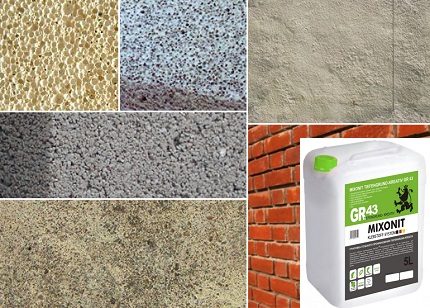
Advantages of using the Mixonit GR43 antifungal emulsion:
- lack of an unpleasant smell;
- parapermeability - a "breathing" protective layer is formed;
- deep penetration - up to 10 cm;
- prevention of mold, fungi, bacteria and algae;
- paintwork consumption reduction;
- drying speed - 3-4 hours;
- resistance to repeated freezing.
Among the disadvantages of the soil is the impossibility of its use on grounds that do not absorb moisture.
Application of 1-2 layers is recommended. On loose surfaces, you must adhere to the "wet" method - the next layer of the emulsion is applied to the previous dry one.
Antifungal Wood Products
Wood is the most susceptible to mold material. It should be treated with insecticides without fail. A tree damaged by a fungus collapses very quickly. Therefore, surface treatment must be carried out annually in a planned manner.
# 1: Dufa-Holzlasur - azure for wood
Dufa-Holzlasur - thin-layer, decorative glaze for restoration of old and protection of new wooden surfaces. Moisture-control and water-repellent coating protects the tree from the negative effects of precipitation.
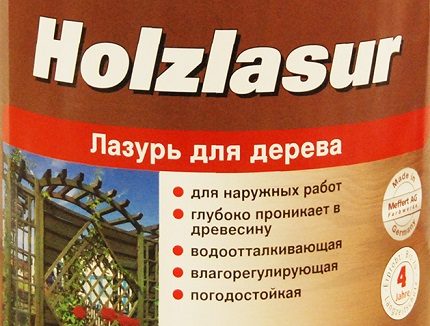
Characteristics of Dufa-Holzlasur:
- a binder is an alkyd resin;
- scope - external processing of wooden surfaces;
- consumption and number of layers depend on the desired staining result;
- wide palette of tinting shades;
- drying time - 4 hours.
Antiseptic Holzveredlung is an analogue of the primer Holzlasur. The only difference is that the Dufa-Holzveredlung glaze forms a glossy finish.
# 2: Baramon C30 - sustainable impregnation
Baramon C30 - fungicide for wood processing. After application to the surface, the drug crystallizes within two days and subsequently is not washed out. The product protects the tree from fungi, mold, bacteria, algae and small insects.
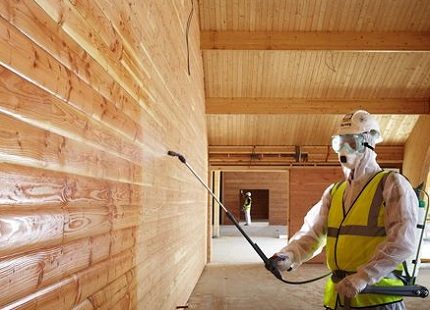
Recommendations for the use of fungicide:
- the concentrate is diluted with water in a ratio of 1: 6, respectively;
- emulsion consumption: 0.2 l / sq. m when processing wood inside the house, 0.3 l / sq m - for outdoor structures;
- within two to three days after applying the product, the surface of the material must be protected from water;
- Baramon C30 is not suitable for tree species that cannot be impregnated, for example, oak.
Contact of food-treated elements with fungicide is not permitted. The concentrate does not increase the flammability of wood.
# 3: Pinotex Base - exterior wall treatment
Pinotex Base is an alkyd based antiseptic primer. It is used for exterior work to process wooden facades, fences, windows and doors before painting. Active substances create a "barrier" from mold, rot and blue.
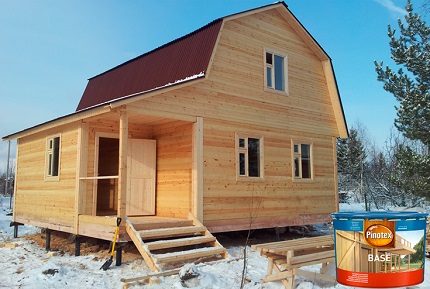
Properties and features of applying Pinotex Base:
- the product penetrates deep into the structure of wood;
- increases the adhesion of the finish to the surface;
- prevents fungal infections;
- during processing, the wood must be dried - the maximum allowable humidity of 20%;
- impregnation does not require dilution with water;
- mortar consumption for sawn wood - 4-8 l / m2, for planed - 6-10 l / m2;
- drying time - 12-24 hours.
It is undesirable to carry out work in windy or hot weather - the active evaporation of the solvent prevents the normal absorption of the primer. Pinotex Base is flammable, therefore it is forbidden to use open fire and smoke near the processing.
Mold control emulsions
You can deal with annoying mold using special means or folk methods. The first option is more effective, and the second is affordable and harmless to humans. In difficult situations, both methods should be combined.
# 1: Ceresit CT 99 - Long-acting
Ceresit CT 99 Antifungal Solution is one of the most popular anti-mildew, fungus, lichen and microorganism control products. The tool is environmentally friendly, can be used for interior work and for processing structures on the street.
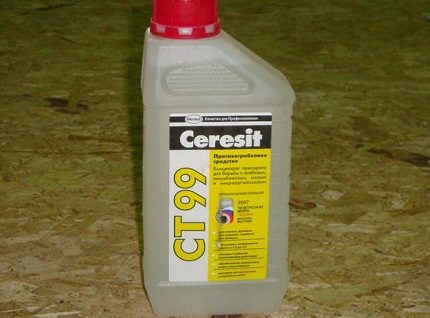
Technical characteristics of Ceresit CT 99:
- active antiseptics - organic biocides;
- heavy metals are not included;
- after processing, no traces remain on the surface;
- the drug is vapor permeable;
- application temperature - up to + 40 ° С, but not lower than + 5 ° С;
- complete drying time - 4-5 hours.
Before use, the drug must be diluted with water, adhering to a proportion of 1: 2 to 1: 5 - the ratio depends on the degree of damage to the wall. The solution is applied only with a brush, spraying is unacceptable.
# 2: ABEDIS 06 - organic plaque removal
Antifungal Abedis 06 copes with organic plaque on the walls, fights against fungal mold in the bathroom, in the kitchen and in adjacent rooms. An important advantage of the drug is its versatility. Abedis 06 is effective on brick walls, glazed and ceramic tiles, stone cladding, plaster, terraces and concrete paths.
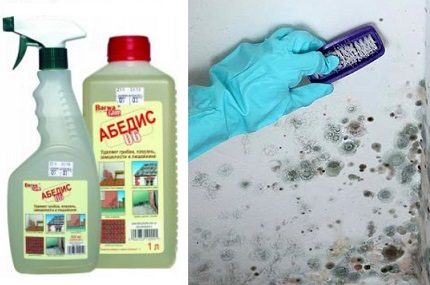
Features of the action and use of the drug:
- after use, the risk of mold reappearance is reduced;
- before application, the concentrate is diluted with water in a ratio of 1: 2;
- the treated wall must be washed with water and dried in a day;
- with severe damage to the walls by the fungus, it is recommended to repeat the procedure after 36 hours.
Consumers note a lasting positive effect after cleansing the surface with an antifungal composition.
# 3: Dali - a universal antiseptic
Dali is a universal remedy that is highly effective against various bio-diseases. It is actively used as a preventative treatment of walls before staining with paintwork, as well as to remove the resulting fungus, blueness and mold.
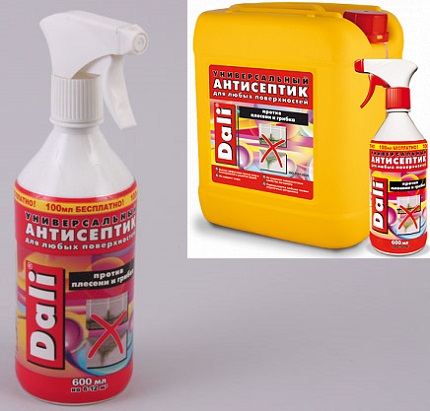
The tactics for disinfection and the consumption of concentrate depend on the purpose of the treatment:
- Prevention The surface is cleaned of dirt and covered with a layer of antiseptic at the rate of 50-100 ml / sq.m.
- Removal of biological lesions. Remove visible colonies of fungi and mold, wipe and dry the wall. To process with the Dali preparation, spending 50-250 ml / sq.m. After 6 hours, repeat the procedure.
During operation, safety precautions must be observed. Wear protective clothing, a respirator, goggles and gloves. The room should be well ventilated.
# 4: Fongifluid Alpa - “treatment” and prevention
Fongifluid Alpa is a fungicidal solution that destroys the source of biodegradation of the wall and prevents re-infection.
The duration of the action is about two years. After applying the concentrate, the coating retains the ability to "breathe", so the microclimate in the room does not deteriorate.
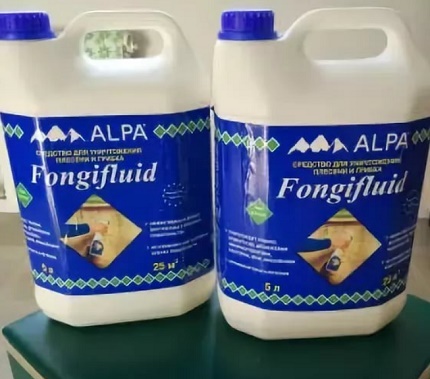
Fongifluid Alpa Features:
- the solution is ready for use;
- drug consumption - 1 liter per 4-5 square meters;
- drying of the surface after 6 hours, the possibility of painting the base - after 6 days.
The antifungal solution is highly effective against a large number of microorganisms. The product does not change color, gloss and texture of the surface.
Alternative methods against mold
If the extent of damage to the walls is insignificant, then it will be possible to prevent the further spread of the fungus using improvised means.
The video presents a test experiment on the effectiveness of various folk methods for removing mold from walls:
Method 1 Bleach. The composition of "whiteness" and similar preparations includes sodium hypochlorite. The component is detrimental to many types of fungi and mold spores. The disadvantages of the method:
- chlorine corrodes the surface and can ruin the walls;
- the active substance works superficially - a fungus remains inside the material;
It should be remembered that working with bleach is not safe for human health.
Method 2 Bleach paired with baking soda. In addition to these basic components, you will also need a liquid soap and a few drops of the essential oil pleasant for you personally. In general, it is not difficult to cope with the preparation and use:
Wishing directly wash the bath until white and put in order plumbing on our site will find a lot of very useful information.
Method 3 Vinegar. An acidic environment is detrimental to many bacteria. Table vinegar is non-toxic, but gives off a pungent odor. This drawback is easily eliminated by providing adequate ventilation.

Method 4 Hydrogen peroxide. The solution has antiseptic, antifungal properties. Processing with a 3% composition is effective, but is fraught with the appearance of spots on the wall - peroxide bleaches the coating.
To apply the product, it is advisable to stock up with a spray gun:
Method 5 Baking soda. The simplest and safest method is to spray a wall with a solution of soda (1 teaspoon of sodium carbonate per liter of water). After 1 hour, wipe the surface with a dry cloth. It is not necessary to remove the remains of the solution - soda will prevent the re-formation of the fungus.
Method 6 Borax (it is sodium tetraborate). The use of natural cleaning products is a priority in terms of maintaining a clean environment.
Buru without problems and prescriptions can be purchased at any pharmacy at a very affordable price.
Method 7 Ammonia. In this case, no additional funds and preparations will be required, although the cost of ammonia can not be called the most budget.
Ammonia is strictly forbidden to mix with bleach, so as not to be poisoned by the extremely toxic gas generated by the combination of these chemicals.It is also unacceptable to add to household cleaning products made on the basis of chlorine or ammonia, for example, to liquids for washing windows.
Conclusions and useful video on the topic
The video will introduce the causes of the appearance of mold, the prerequisites for its appearance, as well as the methods of controlling and preventing this negative phenomenon:
To achieve a positive result in the fight against mold, it is necessary to eliminate the root cause of its formation and choose the optimal antiseptic. To avoid the re-development of microorganisms, it is important to restore the circulation of air in the room and to ensure the dryness of the walls.
Want to share your own effective method of dealing with black mold, or have questions during your reading? Please leave a comment in the block below the text.

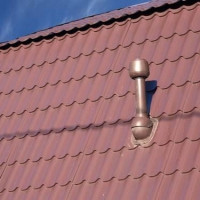 Roof ventilation for metal: an overview of options and nuances of arrangement
Roof ventilation for metal: an overview of options and nuances of arrangement 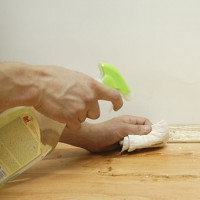 How to remove mold from wooden surfaces: an overview of the most effective methods
How to remove mold from wooden surfaces: an overview of the most effective methods 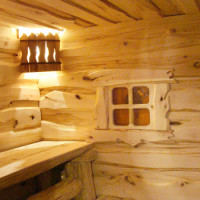 Ventilation in the bath: an overview of traditional schemes and nuances of arrangement
Ventilation in the bath: an overview of traditional schemes and nuances of arrangement 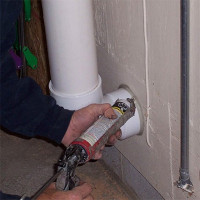 DIY ventilation in the apartment: an overview of the nuances of arranging the ventilation system
DIY ventilation in the apartment: an overview of the nuances of arranging the ventilation system 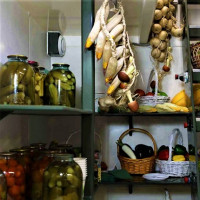 Basement ventilation in a private house: the best ways to arrange proper air exchange
Basement ventilation in a private house: the best ways to arrange proper air exchange 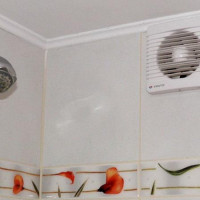 Is forced ventilation in the bathroom necessary: norms and stages of arranging efficient air exchange
Is forced ventilation in the bathroom necessary: norms and stages of arranging efficient air exchange  How much does it cost to connect gas to a private house: the price of organizing gas supply
How much does it cost to connect gas to a private house: the price of organizing gas supply  The best washing machines with dryer: model rating and customer tips
The best washing machines with dryer: model rating and customer tips  What is the color temperature of light and the nuances of choosing the temperature of the lamps to suit your needs
What is the color temperature of light and the nuances of choosing the temperature of the lamps to suit your needs  Replacement of a geyser in an apartment: replacement paperwork + basic norms and requirements
Replacement of a geyser in an apartment: replacement paperwork + basic norms and requirements
From my own experience I can say that it is necessary to fight not with mold itself, but with the causes of its appearance. Otherwise, the result of all funds will be short-lived. By the way, there are mainly problems with windows, which during installation are quite poorly sealed. Moreover, the owners themselves forget to close the outer joint of the window with the building, leaving the mounting foam there in the clear. After solving such problems, it is necessary to treat it with antifungal solutions.
I would like to clarify: is it possible to cope with long-standing mold in the bathroom? We moved into a new apartment in 2008, and there was already black mold in the joints in the bathroom. So far, nothing has been done, and the mold has not grown. Does it make sense to deal with this mold or is it better to completely renovate the premises? And will the repair help in this case? Our bathroom is lined with clapboard.
Mold penetrates the tree very deeply, count through the lining. It will probably be easier to make repairs. In general, it’s been 10 years to go side by side with mold and do nothing, it’s necessary to think of it ...
Hello! Firstly, it is necessary to eliminate the mold, which is now available, thoroughly and clean. There is a good remedy for this, called “Abedis”, I highly recommend it.
Next: most often the cause of mold is the lack of proper ventilation in the bathroom. I advise you to do forced ventilation. And it’s best to set it up so that it turns on with the light. That is, you bought it and let the hood work for 10-15 minutes so that there is no steam, which increases humidity, creating an ideal environment for the formation of mold. And once every three months, do not forget to carry out prophylaxis with the same Abedis solution.
If you are concerned about the constant formation of mold in the bathroom, then removing this infection is just a cure for the symptom, so to speak. Yes, you can choose a good remedy that will correct the situation, but you need to take care of the normal ventilation in the bathroom.
First place the supply valves on the door to the bathroom. They come in different shapes and sizes, I attach the photo. It may be necessary to install a hood with forced ventilation. There is nothing difficult in this; it can be easily combined with a channel for extracting from the kitchen, for example.In this case, the humidity in the s / y will be within normal limits, so mold will not form if you eliminate all the foci beforehand, of course.
Hello. You have lived with mold for so many years 🙁 Immediately make repairs, eliminate the cause of mold growth. In our last house, the children started coughing and we could not cure the cough. It turned out that on one of the walls under the hl a dew point had formed and black mold appeared. And we breathed and coughed.